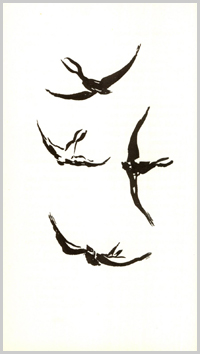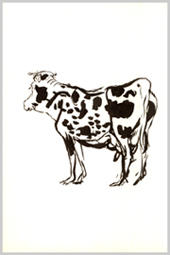Julie recommends Nature Stories by Jules Renard, translated from the French by D. Parmée:
 It’s hard to truly describe nature. A few months ago, I stood overlooking a pond, watching a turtle swim towards a newly-fallen leaf. Each time the turtle attempted to chomp down on the leaf, it was scuttled just beyond reach. The turtle swam in circles, the yellow leaf at its nose-tip, as if magnetized. I stood entranced. What determination! There were plenty of other yellow leaves afloat on the water’s surface. Finally, success—the leaf became lunch.
It’s hard to truly describe nature. A few months ago, I stood overlooking a pond, watching a turtle swim towards a newly-fallen leaf. Each time the turtle attempted to chomp down on the leaf, it was scuttled just beyond reach. The turtle swam in circles, the yellow leaf at its nose-tip, as if magnetized. I stood entranced. What determination! There were plenty of other yellow leaves afloat on the water’s surface. Finally, success—the leaf became lunch.
Beyond books in the realm of eco-lit, or easily digestible books about beloved cats and dogs, it’s difficult to find works of literature that endeavor to see the natural world, not through the lens of romanticism or with politicized aims at correcting our seemingly inexhaustible drive to raze the planet of every last remaining plant and animal, but to describe, simply and accurately the animal-ness of Animalia. First published in a collected edition in 1896, Jules Renard’s Nature Stories is a refreshing take on all things great and small. Personification isn’t overly relied upon in Renard’s short, crisp renderings. As Naomi Bliven of The New Yorker blurbs on the back of the book, Renard’s depictions of animals and plants “are not reflections of Renard. They are not metaphors for his moods. They are not steps in his argument.” While I think it’s impossible to describe anything without having at least a little of one’s self seep onto the page, Bliven is correct in that Renard avoids crowding himself into every scene.
 Take “The Caterpillar” for instance:
Take “The Caterpillar” for instance:
He comes out of a tuft of grass where he’d taken refuge from the heat. He’s rippling over the sandy path, taking care not to stop and, for a moment, thinks he’s got lost: he’s landed in a footmark made by the gardener’s clogs.
When he reaches the strawberry bed, he takes a rest, raises his nose, and sniffs right and left; he then sets off again, over the leaves, under the leaves, he now knows where to go.
Ok, I suppose, in this instance, Renard is completely present, an omniscient force, all knowing about what a caterpillar wants and desires. But isn’t it accurate!? Haven’t we all witnessed this same instance of caterpillar-ness?
Perhaps that’s what I love about Renard, he never moons over his subject; he’s able to capture charm without being overly sentimental or cute. Much of the heft of Nature Stories comes from its humor, a humor magnified even more by the accompanying ink-brush illustrations by Pierre Bonnard (see more examples here). Call it a gift for precision (or laziness), Renard takes extreme delight in first impressions, and a handful of pieces are just a few lines long or less.
Such as this piece titled “The Snake”:
Too long.
A two-word response, and perhaps the best work of short prose that I’ve ever encountered. The piece that made me laugh though until my eyes filled with tears was one called “A Canary,” about a store-bought bird that won’t, to the ever-increasing fury of its owner, sing or take proper advantage of all the little trifles that occupy its cage. The canary “washes himself in his drinking water and drinks his bathwater. He leaves droppings in both of them, indiscriminately.” The comedy arises out of human nature’s crude imaginings about what a canary should be. The speaker rails against the stupidity of the bird, it doesn’t know what do with its biscuit on a string, its sugar stick, its salad leaves, its “bathtub,” but, as it turns out, the real dummy is the one who put the bird in the cage in the first place. Completely fed up, the canary’s owner sets it free. Even then, the bird won’t do what it’s supposed to do, fly away—instead it hops around the windowsill.
trifles that occupy its cage. The canary “washes himself in his drinking water and drinks his bathwater. He leaves droppings in both of them, indiscriminately.” The comedy arises out of human nature’s crude imaginings about what a canary should be. The speaker rails against the stupidity of the bird, it doesn’t know what do with its biscuit on a string, its sugar stick, its salad leaves, its “bathtub,” but, as it turns out, the real dummy is the one who put the bird in the cage in the first place. Completely fed up, the canary’s owner sets it free. Even then, the bird won’t do what it’s supposed to do, fly away—instead it hops around the windowsill.
Readers with sensitive stomachs and zero tolerance for descriptions of animal abuse should probably steer clear of this book. In one vignette, Renard describes so vividly a man beating his dog that it was difficult for me to continue reading. The book also contains several hunting scenes, in which Renard, who was a hunter, expresses regret about his actions—“someone ought to shoot me, bang in the buttocks!”—while maintaining that he has no intention of giving up his reckless killing of partridges.
 For those willing to give Renard’s jubilant writing style a try, his one-page description of trees alone is reason enough to buy this book.
For those willing to give Renard’s jubilant writing style a try, his one-page description of trees alone is reason enough to buy this book.
In “A Family of Trees,” he writes about walking into a densely wooded area:
They welcome me, warily. I may rest and cool down but I can sense that they’re watching me closely and cautiously.
It’s a family, the elders in the middle, surrounded by the youngsters whose first leaves have just been born, more or less everywhere…
In Renard’s version of nature, it decides whether or not it will embrace you. And if you are lucky, it will.
